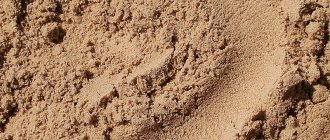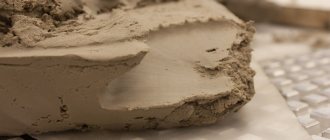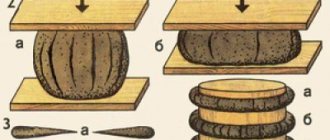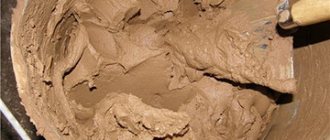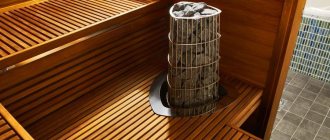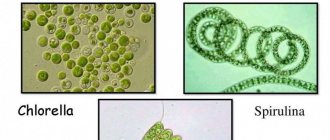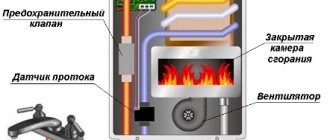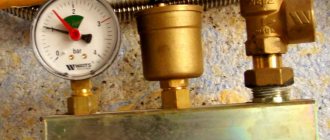Preparing tools and materials for work
Clay walls are plastered in 2-3 layers. Initial plastering of the walls is carried out using the following materials:
- Clays.
- Wood sawdust.
- Sand. Material with medium-sized grains is best suited; large inclusions are recommended to be screened out.
Tools for plastering work.
Special attention should be paid to sawdust, which will be used to plaster the walls. Only thoroughly dried sawdust can be used.
Under no circumstances should they be affected by fungal diseases. Fresh sawdust cannot be used for plastering clay walls. They must be stored for at least 1 year before use. In the process of preparing the mixture, sand is first mixed with sawdust and only then water and clay are added.
The 2nd layer of wall plaster is applied using sand, cement and clay. To work you will need a minimum set of tools, namely:
- Grater board. Instead, you can use 2 spatulas of different sizes. Work with what is more convenient for you.
- Building level.
- Rule.
- Trowel.
For plastering such walls, a special clay composition is used. You will have to select the optimal ratio yourself, because... the properties of clay from different areas, such as plasticity, “fat content,” etc., differ. The optimal proportions of the composition directly depend on this.
Take some sawdust, the same amount of clay and 3 times the amount of sand. Knead the mixture thoroughly, slowly adding water to it. To check the readiness of the plaster composition, you can use various simple and proven methods. Despite their simplicity, they will help you find out without any problems whether the mixture is ready or whether you still need to experiment with the ratio of ingredients.
Scheme for plastering a wall.
The first method is known as the “clay ball”. You need to bring the plaster composition to a state where it no longer sticks to the skin. Roll a small ball from the resulting mass; a diameter of 30 mm will be sufficient. Place this ball on some horizontal surface and crush it with your palm. If cracks appear along the edges, then the composition is not flexible enough, and the proportions will need to be reconsidered. Ideal when there are no cracks. This composition can be safely used for plastering clay walls.
Another method is based on checking the “flagellum”. Prepare a small amount of the mixture and roll it into flagella. There will be enough flagella with a diameter of 2 cm and a length of about 20 cm. Bend the prepared flagella. Check the quality of the composition again by the presence or absence of cracks.
To regulate plasticity, you will need to add less or more sand to the composition. It accounts for about 50-80% of the total mass of the finished mixture. It is more convenient if you have a concrete mixer to prepare the solution. If it is not there, you will need to dig a hole, add the components there and knead the solution with your feet. You can also use a trough for this. It is necessary to check the plasticity of the mixture. Otherwise, during the drying process, the plaster will simply crack and all the work will go down the drain.
If during the work you had to go somewhere and during this time the mixture managed to dry out, to return it to working condition you only need to add a certain amount of water. After this you can return to work. Such properties are an undoubted advantage of such plaster.
Putty materials
Inventive people are ready to give advice on any matter, including the choice of materials for repairing stoves. Recommendations must be taken carefully, separating the wheat from the chaff.
A mixture of clay and sand
There are well-known putty compositions that have been tested many times over. You can use them without any doubt.
It is customary to cover stoves with clay. The material definitely inspires confidence, but first you need to check what type and grade of clay is suitable for making mechanically strong, heat-resistant putty. The stove should be sealed so that it does not crack later.
The composition is prepared by mixing equal parts of clay and sand. Both components must first be sifted and separated from large impurities. Due to the fact that the clay composition in different deposits varies greatly, it is advisable to check the strength of the mixture.
Advice! You need to make balls from the slurry formed after adding water, let them dry well and examine them carefully. If cracking is not visible, the materials are suitable.
It would be advisable to tighten the inspection requirements by throwing dried cakes from a low height. If they did not collapse and successfully passed the tests, the chances of making a high-quality repair of the furnace increase.
When preparing homemade putty, monitor the condition of the wooden mixing spatula. The gruel should not stick to it. If clay adhesion is noticeable, it is better to increase the amount of sand in the mixture.
Of course, if possible, it is advisable to take a special type of clay - fireclay. It is characterized by fire resistance and strength. You can buy it in building materials departments. Before use, fireclay raw materials should be kept in water for a couple of days.
Adding straw and horse manure
A popular folk method of preparing grout for stoves is to add chopped straw or chaff (husks, chaff) to the mixture of clay and sand. You need a lot of it. So, if 4 buckets were taken of clay, one bucket of sand will be needed, and straw - from 40 kg to 45 kg. You can hear advice about the benefits of adding salt to the grout at the rate of half a regular glass per bucket of the mixture. It is recommended that the quality and quantity of additional components be determined based on the local situation.
Important! You cannot use mortar with straw for laying. It is only suitable for covering surface cracks, for plaster.
In some places, people recommend covering stoves with a mixture containing horse manure. Now it is not so easy to find it, it makes no sense to insist on such technology.
Special formulations
If there are building materials stores nearby and you are willing to spend money, it is better to buy ready-made adhesives: soft or hard. The viscous solution is convenient for covering small cracks. Complete plastering of the stove can be done with solid compounds. Sometimes cracks in the masonry are sealed with a special heat-resistant sealant, and small cracks are filled with asbestos fiber.
Note! The finished product contains clay, sand, cement of proven quality, mineral and synthetic additives.
If the solution or paste is prepared correctly and the work is done correctly, the result is guaranteed by the manufacturer. What is important is that special putty compounds can be used if the stove is finished with tiles or decorative bricks. They are plastic, prevent the formation of repeated cracks and provide reliable adhesion to the masonry.
Where is clay plaster used?
For many years, clay plaster was used, perhaps, only for laying partitions indoors, as well as for finishing and laying stoves and fireplaces.
But, if you look at old buildings plastered with clay compounds, you can be sure that it is still in good use. Red brick partitions are also very durable, in the masonry of which cement-clay mixtures are often used. Moreover, unlike fragile drywall, you can hang heavy racks on them without fear of them falling.
Clay-sand mortar is most often used to plaster wooden and clay (adobe) walls not only outside, but also inside the house. In principle, any surface can be plastered with clay. The main thing is to prepare them correctly, as well as select the fat content of the clay and maintain the proportions with additives (sand, sawdust, straw) in the solution.
This environmentally friendly material is able to absorb excess moisture and release it as needed. Clay plaster containing flax or straw fibers looks original, which is why designers and craftsmen are increasingly using it as a decorative finish.
.
Use sugar clay to repair ceramics
The method is suitable for filling wide cracks (several millimeters) in an almost dry product.
Sugar clay is clay chips, clay that has dried and crumbled into small grains mixed with powdered sugar. You can buy sugar clay in an online store for DIY goods or crafts. Or get it yourself.
Repairing ceramics using sugar clay in three steps:
- Thoroughly mix a little clay chips with an equal amount of powdered sugar.
- Clean the crack and smooth the edges so that the grout fills it all without leaving any voids.
- Moisten the edges of the crack with a small amount of vinegar and place sugar clay into it.
Advantages of the method:
- First. Compared to water, powdered sugar softens clay better and gives it greater plasticity.
- Second. When dried, sugar clay shrinks much less than regular wet clay. This means that the risk of a crack occurring is minimal.
Plastering with clay
The principle of working with a clay mixture is essentially no different from working with conventional plaster:
- Beacon profiles are also placed for alignment.
- To obtain a durable surface without cracking, the thickness of each layer should not be more than 10-15 mm.
- In case of strong slopes and the need to apply a solution of greater thickness, clay-straw or sawdust mixtures are used, which can be applied to shingle-reinforced walls in a large layer.
- If necessary, a new layer is added on top of the first only after the surface has dried.
- After finishing with shingles, the walls are dust-free and moistened with water.
- The surface is moistened abundantly so that it does not take liquid from the solution and weaken the plaster.
- The solution is applied with force to ensure better adhesion.
- To reduce the formation of cracks, it is advisable to add fiber additives to the solution.
The video below shows how to plaster a wall made of clay or wood.
We inspect and select material
Stove
Before starting work, determine the extent of the damage. Even if small cracks appear, all old mortar in this place should be removed right down to the brickwork. The cleaned area should be covered with a solution, but what should you use to cover the stove so that it does not crack? This question interests many, and there are the following options for building mixtures that are most suitable for brick kilns:
- clay and sand;
- construction grout for stoves;
- fireclay clay;
- oven glue.
The simplest and most economical option is clay-sand mortar, which was still used by our ancestors. The quality of clay coating is not inferior to modern mortars, but it is much cheaper. Any clay is suitable for oven mortar; it is desirable that it contains no foreign impurities. The clay is placed in water for 12 hours, after which it becomes plastic and homogeneous.
You can buy fireclay clay at the construction market. This material is specially designed for creating fire-resistant elements, bricks, blocks, and is also used for laying stoves. The material, like products made from fireclay clay, is distinguished by high quality, fire resistance and durability. Fireclay clay is inexpensive in hardware stores and is sold in 20 kg bags, with instructions for use included.
Instructions for applying clay plaster
First of all, you need to prepare all the necessary tools and materials:
- Mixing container or concrete mixer;
- Spatulas of different sizes for plastering walls;
- A sieve for straining the solution;
- Hammer or screwdriver;
- Fasteners (nails or screws);
- Reinforcing mesh or shingles.
After this, you can begin preparing the base:
- Before plastering with clay, remove the old coating, especially if we are talking about cement plaster.
- The surface is thoroughly cleaned, fasteners are removed from it, and protruding reinforcement is trimmed with a grinder.
- The area to be treated is roughened using a grinding machine. If the walls are made of wood, then the installation of shingles will be required.
Preparation of the solution
To properly make a clay composition, you need to be guided only by the fat content of the solution.
There are no exact formulas, instructions or proportions, as, for example, for gypsum or cement mixtures. The classic recipe contains straw, but the factory production technology involves the use of polypropylene fiber.
There are two ways to test the plasticity of clay:
- First you need to put the clay in a container and fill it with water, then knead it using an electric drill with a mixer attachment. A properly prepared solution should not stick to your hands. From the finished plaster you need to make a small ball with your own hands (just roll it in your palm) and flatten it into a flat cake. Then you need to examine its edges: if they are cracked, it means there is a lot of sand in the solution and not enough clay and water. A correctly manufactured composition, after compression, forms an even “pancake” without breaks.
- You can also roll not a ball, but a flagellum up to 20 cm long. It must be bent in an arc; if cracks appear on the surface, it means that the solution does not have enough clay.
Instructions for applying clay compositions with your own hands:
- Patches of mortar are applied to the entire wall at even intervals, after which they take a wide spatula, trowel or rule and stretch the material over the surface using the selected tool.
- Levelness is checked using a building level; if necessary, another layer of plaster is applied.
- The surface is left to dry for a month in summer and 3 months in winter.
- Then you need to do the finishing touches. To do this, first of all, prepare a solution from clay of a more liquid consistency than for rough work. The ratio is as follows: 1 part clay, 1 part cement, 3 parts sand.
- The mixture is applied in a thin layer to the wall and carefully leveled with hand tools, after which the surface is left to dry for 3-4 weeks.
At the end the walls are whitewashed with lime whitewash. You can also rub the clay coating with a float, treat it with a primer, and plaster the top with gypsum mortar. This completes the clay plastering.
Plastering walls with clay with your own hands is a fairly simple process. Unlike working with other materials, it does not require precise calculations and careful surface preparation. The main thing is to follow the above instructions and check the walls with a level as often as possible.
Problems with the strength of plaster arise quite often at the initial stage of finishing work. Plaster cracks not only on the outer surface; cracks are observed in the most unexpected places. The appearance and development of cracks is expressed at the outer corners of the walls, especially in the lower part adjacent to the base surfaces of the masonry. Less commonly, plaster finishes can crack, peel off in sections, and eventually fall off the wall.
To prevent clay from cracking in the oven: rules for choosing a solution
During operation, a crack may form on the surface of the stove masonry. This is caused by uneven heating of the material from which the masonry was made. Through cracks pose a danger to people because carbon monoxide enters the room through them. This means that damaged areas must be repaired immediately. But first, it is recommended to find out what needs to be done to prevent the clay from cracking.
Why does clay crack?
One common reason is an overly thick seam
The surface of the clay layer can crack for various reasons, and yet why this happens, consider the probable reasons and find out what to do to prevent the clay from cracking when drying:
- excessively thick layer. To avoid this, plaster with clay, applying a maximum two-centimeter layer. If there is a need to apply a second one, then the previous one should set well. In good weather, this takes at least a day. If it is intended to apply a plaster layer more than four centimeters thick, the surface must be reinforced with steel mesh;
- the plaster dries too quickly and begins to crack. Optimal conditions for this are 10 – 20 degrees Celsius. If the weather is hot, it is recommended to suspend work and moisten the walls more often. Perhaps the base of the wall quickly absorbs moisture. In this case, it is also moisturized abundantly;
- the solution turned out to be too greasy. Replace the clay or reduce its amount in the solution. The same applies to cement material.
Types of clay-based plasters
Let's consider the main options for plasters and the technology for their preparation.
Fireclay clay
Fireclay clay
Difficulties arise in the work, the bricks hold weakly in the masonry, the plaster layer is covered with numerous cracks. This is due to the fact that during the firing process the clay almost completely loses its plasticity, which must be returned to it when preparing the solution. In these cases, craftsmen recommend adding quartz sand or a special adhesive composition. The procedure for preparing the solution is as follows:
- you will need a pack of fireclay powder, which is poured into a container;
- water is added gradually until it covers the entire mass;
- it is necessary to wait three days for the material to infuse;
- after this sand is added. If the solution turns out to be thick, you can add water, otherwise the clay layer will crack when it dries;
- The mass is thoroughly mixed.
A properly prepared solution should resemble thick sour cream in thickness, only in this case it will not drain and will adhere perfectly to the surface. To speed up the drying process and take measures to prevent the clay from cracking, it is necessary to add cement at the rate of two kilograms per package of fireclay.
It is possible to purchase ready-to-mix formulations that do not require steeping for three days.
Clay-sand mortar
How to properly make such a solution so that the clay does not crack? First you need to sift the sand, for which you will need a sieve with a hole size of 2 - 3 mm. Its amount will depend on the degree of fat content of the clay.
The clay is pre-soaked. It is placed in a tank and filled with water, leaving for one to two days. After this, the mass is mixed and passed through a three-millimeter sieve. The result should be a solution that is similar in thickness to sour cream.
We start adding sand. As a rule, one and a half times more sand is required per liter of solution. But when the clay is oily and the solution is prepared in such proportions, then cracks will definitely appear. And with low-fat clay, the layer of plaster will not be durable.
The ratio of sand and clay should be accurately determined. For this purpose, take a liter of solution, to which sand is added in doses, while stirring the mass. The end result should be a material that easily slides off a metal shovel, but does not spread over it.
Clay-sand mortar
Clay-sand mortar with added fiber
What other clay solution can be used to cover the stove so that it does not crack? To do this, a small amount of cement is added to the working composition - a trowel per bucket.
If it is necessary to coat the stove to seal cracks, add simple table salt to the solution - up to five hundred grams per bucket. This gives the mixture strength and allows it to be more reliably held on the masonry surface.
Some craftsmen add a small amount of sheet asbestos soaked in water to the mortar mass. It is simply torn into small pieces and soaked in water. After a few minutes, the asbestos separates into individual fibers that reinforce the solution. The slurry obtained in this way is added to a solution of sand and clay, mixed and used as the first coating layer.
Nuances of testing clay plasticity
Different clays differ in their plasticity. There are:
- “fat” clays with high plasticity;
- material of medium ductility;
- “lean” clays with a low level of plasticity.
Dust
In order not to later wonder what to do if the plaster on the walls cracks, you need to remove dust from the surfaces treated with it in advance, and to the maximum. Its presence significantly impairs the adhesion of the liquid solution, as a result of which cracks will certainly appear on the walls or ceiling, albeit not immediately.
It is worth noting that it is not at all necessary to dust all walls and ceilings. It is enough to moisten them a little from a spray bottle, but only before starting finishing work, and not in advance.
Gypsum plaster: subtleties of use
The answer to why gypsum plaster cracks literally immediately after drying sounds different than in the situation with its cement-sand counterpart. In this situation, the primary sources of defects are as follows:
- Gypsum plaster cracks when drying where the surfaces being treated have not undergone rough preparation. That is, cracks and voids were not removed from them, into which gypsum would then gradually penetrate, causing ruptures in the decorative layer.
- Excess water is why plaster on walls cracks, because gypsum mixtures are extremely susceptible to large amounts of moisture, which weakens their structure. This is especially true when a slightly dried working solution is diluted with water.
- Another important indicator is the thickness of the applied layer, which cannot be less than 0.5 cm. Otherwise, the moisture will evaporate very quickly and the coating will inevitably “tear”.
It turns out that cracking of plaster is the result of an irresponsible attitude towards its use and disregard for the recommendations specified by the manufacturers. In general, this is a fairly easy-to-use coating that allows you to make a budget-friendly, high-quality, and most importantly, environmentally friendly base for future decorative coating.
Clay plaster, the composition of which is simple and literally lies under our feet, is increasingly found on construction sites as a facing material for interior and exterior decoration. It is known that it was the main material for masters many centuries ago, why are we returning to this experience again today?
Preparation of plaster mortar
Unfortunately, preparing the solution yourself and plastering the walls with it is quite difficult.
This process is not only labor-intensive, but also very lengthy: the clay takes a long time to dry. But the result is worth it, so for those who decide to use this material, we suggest you watch how clay plastering is done in a video and carefully study the recommendations below.
What should be included in plaster?
The main components are ordinary clay, sand and water. A solution prepared only from them has high thermal conductivity, so it is usually used only for making the final leveling layer. For rough finishing, the task of which is to strengthen the thermal insulation of the walls, plaster with filler is made.
It can be:
Chopped straw or hay;
- Hemp or flax fibers;
- Wood sawdust or shavings, preferably pine, oak, alder;
- Kizyak (horse manure).
All these materials have long been used by our ancestors, and they knew a lot about insulating their homes. Today, modern fillers have been added to them, which can be used without fear. These include various fibers and granulated polystyrene foam.
There are other options:
- For example, if you plan to plaster stoves with clay, then cement, asbestos or fiberglass are often added to the solution to give the plaster greater strength.
- To make decorative clay plaster, colored clay (white, yellow, blue) is used, pigments and ground mineral fillers are added to it.
Preparation of the solution
You can use any clay, but it comes in different fat contents, so you will have to determine the ratio of all components in the plaster experimentally. To choose the proportions, first prepare a little solution.
The instructions are:
- Take one part of the clay and fill it with water for a day, which should be 3-4 times larger in volume;
- Mix the solution thoroughly, kneading all lumps until a homogeneous mass is obtained;
- Stirring occasionally, start adding sifted sand to it. For clay of normal fat content, four parts of sand are required, but you add it until the mass begins to slide off the trowel easily.
Now you need to test in one of the following ways:
- Method 1.
Roll a small ball, lift it a meter from the floor and drop it. It should not fall apart or crack from impact. - Method 2.
Roll out the resulting mass into a rope 15-20 cm long and about 2 cm in diameter, place it on a flat surface and bend it in an arc. There should be no tears or cracks on the fold.
If your samples fail the test, they have too much sand.
Having figured out the proportions, you can prepare the solution in the required volume by adding fillers and water. Sawdust or chopped straw for heat-insulating rough plaster should be about half of the total volume or slightly less. Add them and water gradually until you get the desired consistency.
Now it's time to learn how to plaster with clay.
How to cover the stove - choose a solution and restore the stove yourself
Figure 4. Plaster over reinforcing mesh
To prevent the stove from cracking, you need to take a competent approach to its construction and operation. But if cracks do appear, they need to be eliminated as quickly as possible. Regardless of the type of mixture, the structure should be prepared before restoration. The surface is cleaned of dirt and debris, and the cracks are deepened and widened. If there are bumps and sagging on the base, they are knocked down.
Before coating, the hearth must be heated. Due to the high temperature, the furnace materials will increase in volume. This will avoid repeated cracking immediately after post-restoration heating.
If there are few “seams”, they are sealed locally before plastering. Otherwise, a complete coating is used - the entire surface is covered with liquid heat-resistant putty.
Scheme of work
Figure 5. Local filling of cracks
In general, the procedure is as follows:
- clean the base and perform other additional work;
- cover the surface with a thin layer of liquid mixture and allow the putty to dry;
- reinforce the base (or cracks, if the repair is local); for this purpose, a metal mesh with small meshes is used; fasten the reinforcement with nails or dowels; as an alternative to the mesh, you can use burlap soaked in putty; It is preferable to use it to seal cracks pointwise;
- after the starting layer has dried, the fireplace is plastered; the oven is coated in two layers - the thickness of each layer is no more than 5 mm.
The next steps are at the discretion of the stove owner. The structure is covered with whitewash or decorated in another way.
Scheme of work
Sooner or later, owners of country houses and private houses will have to solve the problem - how to cover the stove? A failed heating device poses a threat to the life and health of the inhabitants of the house. It is no coincidence that fire safety regulations prohibit the operation of a faulty stove. The work of a master stove maker is not cheap. However, if necessary, you can repair the “heart of the house” yourself.
The oven can fail for various reasons. Sometimes it’s easier not to cover up any defects that appear, but to rebuild the stove. However, such drastic measures are rarely required. As a rule, the main reasons for the emergency condition are shrinkage, poor-quality materials and errors made when laying out the fireplace.
Heating systems require regular maintenance. According to SNiP standards, heating devices in a dacha must be inspected twice a year. And in a private house at least once a quarter. Unfortunately, most homeowners neglect these requirements.
Only a complete oven can be used
The main danger for the residents of the house is not a collapsed fireplace, but the cracks that appear in it. The explanation is simple - no one will heat a stove that is obviously in emergency condition, but cracks cannot always be noticed in time. Carbon smoke leaking through them is a serious danger for the inhabitants of the house. According to statistics provided by the Ministry of Emergency Situations, in a fire, 70% of people die from smoke, and of those who survive, 42% end up in hospital with carbon monoxide poisoning.
Therefore, timely repairs are the key to the safety of your family. Most stove makers, when asked: “how to seal the stove so that it does not crack from the heat?”, will advise using clay. However, there is a nuance here. There are several types of mixtures and almost all of them use clay.
Clay is the main component in the manufacture of masonry stove mixtures. This is explained by its unique quality - when heated, it turns into stone. The clay solution can withstand high temperatures and ensures the reliability of the entire structure. But other ingredients are also used for production. Clay is divided into two types: dry and oily. When heated, the first one crumbles, and the second one cracks and dries out.
Proper laying of bricks on clay mortar
We invite you to familiarize yourself with Strawberry Kent. Strawberry variety Kent description and reviews
Note that the ratio of solution components will always be different. Each time the proportions are determined through experiments. After all, no two absolutely identical breeds are ever found in nature. For each solution, depending on the fat content of the clay, the ideal combination of ingredients will change.
The quality of the breed is determined as follows. You need to roll up a clay cord 1 cm thick and 20 cm long, and then wrap it around a wooden piece with a diameter of 5 cm. A strand of normal clay gradually stretches and when its thickness decreases by more than 70% of the initial volume, it breaks.
The most common is a mixture of clay and sand. It is in demand for laying, finishing and repairing fireplaces.
The name “clay-sand mortar” speaks for itself. It consists of sand, clay and water. Oddly enough, problems can arise even with water - it should not contain mineral salts and silt. Otherwise, even whitewashing will not save you from protruding salt stains. At the beginning of the 20th century, craftsmen used rainwater to mix the solution. However, it is not only water that needs purification.
The sand used to prepare the solution is first sifted through a sieve. This allows you to clear it of gravel, grass and roots, which makes the masonry joint thin and neat. Before you start mixing the solution, the clay must be soaked in warm water for 12 hours.
Prepare the clay-sand mortar correctly
The step-by-step production of the mixture is as follows:
- 1. Stir the wet clay solution - there should be no lumps in it.
- 2. Add sifted sand to the prepared mixture. The optimal combination is 4 parts clay and 2 sand. Although the amount of sand depends on the clay, or more precisely, its fat content.
- 3. Sometimes, if whitewashing of the hearth is not planned, lime is added to the solution. After mixing the solution until creamy, cover the container with plastic wrap and forget about it for 12 hours.
- 4. Don’t forget to stir the settled mixture, and then form a ball out of it and squeeze it - if cracks appear, add more water.
- 5. Straw is added to the clay as a reinforcing layer. However, today more reliable materials have appeared. When restoring the stove, cover it with plaster mesh, this will allow you to forget about repairs for a long time.
Despite the low cost of the components, such a clay-sand mortar confidently competes with modern construction grouts and adhesives.
Fireclay clay is often used in the construction and repair of brick kilns. After heat treatment, this rock receives additional properties. Kaolin clay is used to make fireclay. During heat treatment (1500 degrees), it turned into stone. The resulting stone powder is added to the mortar when repairing or constructing a furnace.
Follow all recommendations when repairing the furnace
Fireclay clay differs from similar materials in the following advantages:
- resistance to high temperatures,
- vapor permeability,
- high adhesive properties.
In addition, fireclay clay is safe for human health and will ensure a long service life of the fireplace. Unfortunately, there were some negative qualities.
- uneven surface heating;
- violation of masonry technology;
- use of low-quality material.
Let's divide the process into three stages, you will need:
- Diagnose the damage.
- Prepare the solution.
- Plaster the stove.
First you need to inspect the extent of the damage and decide on the scope of work. If the damage is minor, then you can get by with superficial work - clean the brick from the finishing and plaster, seal the cracks and plaster the stove. If you observe large through gaps, damage to the cladding or masonry, you will have to disassemble and repair it.
Regardless of the damage, you will need to prepare a mixture. Depending on the funds allocated for repairs and available materials, the following types of mortar can be used for repairs:
- from fireclay clay;
- ordinary clay and sand;
- grout for the stove (you can buy it or make it yourself);
- oven glue.
Proportions of components of different mortars for masonry and plastering of stoves
Let's look at these options in more detail.
How and why plaster cracks
To answer the question unambiguously, a small analysis of the circumstances and conditions of destruction of the plaster mass will be required. Plaster warps and cracks most often due to deviations in the technological process:
- Violation of the proportions of the main binders of the plaster;
- Exceeding the optimal layer applied once to the wall, incorrect drying mode of the plaster layer;
- Violation of mixing technology when preparing plaster solution;
- Using materials unsuitable for kneading;
- Settlement or violation of the integrity of load-bearing walls, “the foundation floats.”
Advice! If the plaster begins to crack, the first thing you need to do is immediately check to see if the load-bearing structures of the walls are being destroyed. Otherwise, behind the problem of plaster, you may not notice how the building itself begins to crack and collapse.
In such cases, the depth of the cracks is checked with a special probe made of thin steel wire. If the probe penetrates to a depth exceeding the thickness of the plaster, it means... the problems are more serious than poor-quality wall finishing.
How to coat a stove with clay
The choice of how to seal the stove so as not to crack depends on what mixture you decide to use. But first you need to clean the bricks from the plaster and the layer of finishing material. They are then treated with a solution.
If you decide to use a clay mixture, then you need to follow the instructions on how to properly coat the stove with clay:
- The prepared solution is stirred one more time.
- They check its quality. To do this, roll the mixture into a ball and if it starts to crack, then add water.
- Before coating the stove with clay to prevent it from cracking, the damaged areas are moistened with water.
- The cracks are filled with the solution.
- Then the oven can be plastered.
- Despite the fact that the repair of the brick kiln is completed, you should not rush to heat the unit, since the solution must dry completely.
Advantages and disadvantages of the material
This type of finishing work, such as clay plaster, has a huge number of advantages:
- naturalness of the material;
- with its help you can adjust the ideal humidity level in the room;
- due to its absorbent properties, this coating will be able to absorb harmful substances from the surrounding space;
- clay is an elastic, fire-resistant and waterproofing material;
- the material is ideal for covering various surfaces: brick, wood, concrete, etc.;
- a clay-based solution is quite easy to apply with your own hands, even for beginners;
- is distinguished by its low cost.
This type of finishing work, such as clay plaster, has a huge number of advantages.
As you can see, the advantages are quite significant, but, of course, there are also disadvantages, albeit in small quantities. The main disadvantage is the difficulty in finding truly high-quality and environmentally friendly material that would not be contaminated with radioactive substances and other human waste. The second disadvantage is the long drying time of the surface treated with clay. At room temperature, such plaster (if its layer is no more than 1 cm) will dry for at least 5 days, and when the temperature rises to 350C - at least 2 days. Whether to use the lengthy process of applying clay plaster or use more modern techniques and materials - the choice is now yours.
How to remove old plaster from walls?
Volumetric plaster on the wall: features and application technique
Plastering drywall: what do you need to know before starting work?
Today, when we, having become saturated with modern technologies, again strive to decorate our homes with environmentally friendly materials that do not contain toxic and harmful substances, clay plaster is becoming increasingly popular again - its composition is completely natural, all the components were given to us by nature.
Unfortunately, there are fewer and fewer good craftsmen who perfectly know the technology of its preparation and application, but if you want, you can handle this matter yourself.
Almost all packaging with modern plaster mixtures (see) bears a mark about the environmental safety of the product. And in most cases it is true. And yet, their composition often includes synthetic additives that give the material plasticity, frost resistance, increased strength and other useful properties.
Clay plasters consist entirely of only natural materials: clay itself, sand and fillers such as sawdust, straw, pine needles, etc. They have a lot of advantages that even the highest quality and most expensive plasters on cement, gypsum (see) and, especially, polymer bases do not have.
So:
- Having an excellent ability to accumulate moisture from the air and release it back, clay provides climate control in the room;
- It also accumulates heat and gradually releases it when the air temperature drops. Even to the touch it is always warm and pleasant;
- This plaster perfectly absorbs odors and is a good barrier to extraneous sounds from the street and high-frequency radiation;
- Has antiseptic properties, prevents the appearance of mold on the walls;
- Another excellent property is the ability to “breathe”, passing through the vapors contained in the air. Wooden structures that have such protection always remain dry, do not rot and are not attacked by insect pests;
- Clay plaster can be reused by soaking it with water. The same is done with a frozen working solution, so no waste remains during repairs;
- It can be used on any base: wood, brick, concrete, cinder block, etc.;
Of course, an important advantage is the extremely low price of the material. It may not cost you anything at all if you use clay for plastering from a pit dug under the foundation, and bring sand from the river bank. But ready-made mixtures usually cost no more.
Solution and its use
When mixing the solution, the main thing to consider is the place of its application.
The most popular recipe for clay plaster is considered to be a lime-clay mortar, which is mixed as follows:
- on the eve of work, soak the clay for 24 hours;
- Before you start kneading, the clay needs to be kneaded thoroughly;
- mix lime and crushed clay in some container;
- You can add sand to the resulting mixture in small portions, add a little water without ceasing to stir;
- if the clay has a “sticky” consistency, you need to add more sand to the solution;
- to make the solution stronger, you need to add a secret ingredient such as sawdust or straw into it;
- Before adding sawdust to the solution, they must be sifted;
- To give the mixture viscosity, add a little cement or gypsum to it.
The most popular recipe for clay plaster is lime-clay mortar.
In order for the sawdust in the solution not to swell and absorb all the moisture, they must first be well soaked in water and allowed to “rest” a little so that the excess liquid is drained off. Also, you should not use plaster containing dry sawdust or straw to finish the surface. This will give the walls unevenness, and further smoothing them may result in fragments of clay finishing falling out. When mixing the solution, try to pour water in small portions so that you can control its consistency.
There are clay solutions that were invented specifically for plastering high-temperature surfaces. They contain a substance that increases the heat resistance of the plaster - asbestos.
Application of clay plaster
There are many variations of this solution that you can prepare with your own hands without much effort and knowledge; let’s look at the most popular ones:
- Composition No. 1
In this case, cement is not used, but the following proportion must be observed: 3 parts clay, 2 lime, 1 gypsum, 1 sand, and the main component of the mixture is 1/5 asbestos. - Composition No. 2
This mixture is mixed without adding gypsum, but more clay is required - 4 parts. The composition should also contain: 4 times less cement and lime, 2 times less sand, and 10 times less asbestos. - Composition No. 3
This composition is the most elementary, and the proportion looks like this: 1 part clay, 1 cement, 2 sand, 1/10 asbestos.
Using these types of clay mortar, you can easily create a very warm and cozy room with your own hands.
Exterior finishing with clay plaster
Classification of clay mortars
The variety of clay compositions is also reflected in the classification of the plaster itself for which it is used.
Clay plaster can be obtained from the following components:
- from light clay, the plasticity of which is 0.17-0.27;
- from heavy, ductility more than 0.27.
The second option is used much less frequently, because due to its density it cracks over the years under the influence of temperature changes, and the proportions have absolutely nothing to do with it.
The color range of this building material is very diverse:
- white (kaolin);
- gray;
- black;
- red (most often used in construction work);
- yellow;
- blue.
Decorative clay plaster
Please note that the natural composition of clay does not always indicate the environmental purity of the product. Always pay special attention to the composition of the clay
The following components can be added to it in various proportions:
- dolomite;
- calcite;
- quartz;
- magnetite;
- cellulose;
- sodium gluconate;
- urea.
Clay decorative plaster
Below is a table of variations in the composition of the mixture in volumetric parts.
| Components | Composition of the mixture in volume parts | ||||
| A | B | C | D | E | |
| Cast mortar (based on soil and sand in a ratio of 1:2) | 10 | 10 | 10 | 10 | 10 |
| Sand | 25 | 25 | 25 | 25 | 25 |
| Cellulose | — | 5 | 5 | — | 5 |
| Casein glue | 1 | — | — | — | 1 |
| Urea | — | — | 0,2 | — | — |
| Sodium gluconate | — | 0,2 | — | — | — |
Studies carried out at one time have proven that the addition of such impurities to the composition of clay plaster simplifies the process of laying the mixture and improves its strength. But, be careful with your choice, because all such supplements have a high level of natural radioactivity. It is better not to use clay with a “dangerous” composition at all when plastering surfaces, and do not hesitate to ask the seller about the place where the material was mined. And also remember that the proportions of additives greatly affect the elasticity of the clay solution.
What to do to avoid drying cracks
- First of all, of course, follow the technology for making ceramics.
- Secondly, to achieve a relatively uniform thickness of the walls and bottom of the product. If you are sure that the thickness of the walls and bottom is approximately the same, then this is already half the success. Sometimes you can remove excess thickness before finishing the job. If you did not have time to “finish” the product directly during creation, grooving the bottom can help, but for this the product must dry enough so that no deformation occurs during post-firing processing.
- Thirdly, artificially slow down the rate of drying of ceramics. In such cases, ceramics are placed to dry in cool rooms, but without drafts, since a sharp change in the rate of moisture evaporation from the surface can again lead to uneven drying. In any case, the batteries should be kept away from the ceramics, otherwise the drying will again be uneven. You can also artificially and slightly increase the air humidity in the room, or moisten the drying ceramics. But slowing down the drying speed is not always possible, especially when the workshop has only one room.
Therefore, the solution is often to accelerate the drying time of raw products while maintaining its uniformity. Sometimes the bottom of a ceramic product is dried with a hairdryer immediately after production. But here it is important not to overdo it, since a hairdryer can cause uneven drying of the outer surface of the work, which, on the contrary, should be avoided. If the goal is to achieve uniform drying, then proceed as follows
First of all, the product must be placed with its bottom on a moisture-absorbing surface; the classic option is a plaster circle or plaster stand. But plastic will not work. As a last resort, you can put regular newspaper, which, due to its “looseness,” absorbs moisture very well. Our next task is to ensure uniform drying of the walls and bottom. When drying, ceramics are sometimes placed in bags or covered with glass caps
If the goal is to achieve uniform drying, then we proceed as follows. First of all, the product must be placed with its bottom on a moisture-absorbing surface; the classic option is a plaster circle or plaster stand. But plastic will not work. As a last resort, you can put regular newspaper, which, due to its “looseness,” absorbs moisture very well. Our next task is to ensure uniform drying of the walls and bottom. When drying, ceramics are sometimes placed in bags or covered with glass caps.
For uniform drying, the thin wall needs to dry in the same amount of time as the thicker bottom. Therefore, the optimal option is when the walls of the product are covered (a plastic bag selected according to size is quite suitable), and air access is provided to the bottom. However, here you need to take into account the dimensions and not leave the drying ceramics unattended, periodically checking the uniformity of drying of the mass throughout the product.
The main causes of cracks when drying ceramics:
poor-quality ceramic paste
As a result, the clay in the product has a different density and, as a result, a different drying rate, about the consequences of which read further.
different thickness of walls and bottom
When dried, the ceramic mass shrinks, that is, it becomes deformed, and this leads to stress in the material. Therefore, uniform drying is extremely important for ceramics, that is, so that natural deformation evenly affects the entire product.
If the bottom is thicker than the walls, then during natural drying the thin walls dry faster than the bottom, and in this case we are no longer talking about uniform drying. Thus, the product cannot be deformed evenly or bonded, which usually results in a crack at the bottom resembling an “S” shape.
air temperature and humidity
In winter, as a rule, the temperature in the room is quite high, and the relative humidity, on the contrary, is low, and the clay “behaves” differently than in the summer.
What is product drying from a physics point of view? Water is brought from the inner layers to the surface as a result of capillary effect, from where it evaporates. Under normal conditions, this process occurs slowly and, accordingly, evenly.
When the air is dry, water from the surface evaporates faster than moisture has time to penetrate to the surface from the inner layers. That is, the outer surface is no longer plastic, and the inner layer remains damp and unstable. Consequently, the inner layer of the material shrinks when it dries, which leads to stress and, as a consequence, cracks.
Best answers
Garniy Khlopchik:
Now listen to the correct answer from a professional. To “lean out” fatty clay, up to 30% of burnt ground clay is added to it. Sand causes problems during firing, so it is not used. The mixture is called CHAMOT. Such a mass can be up to 10 cm thick, subject to slow drying. The fire shrinkage of fireclay is also small, which is why all monumental ceramics are made from it.
Veloria Granta:
yolk or maybe liquid glass
VASILY login:
add regular sand. and the proportions depend on the purpose
Dr.Evil:
The drying mode, plasticizer additives, including organic ones, depend on the purpose and further technical process - firing, coating with something, etc.
Vladimir Ivanov:
Guys, don't worry: asbestos powder is added.
Konstantin:
if the clay cracks when drying...it means it is “oily”...add sifted sand...preferably river sand...
Anastasia Babashkina:
Sand is sand, but there is a point - the clay must be kneaded well, all of it, piece by piece, in order to extract all the fragments of stones, glass, and debris from it. Because it is because of foreign bodies that the work cracks in half the cases, and when fired, it simply falls into pieces.
Grout
What else can I put on the stove to prevent it from cracking? Stores sell a variety of construction grouts, including those for stove finishing. For finishing work with fireplaces and stoves, this is a good option, but the cost of the material is much more expensive than a self-prepared composition. If you want to save money, there is an alternative option for preparing the mixture at home. To do this, stock up on the following materials: sand, clay, straw and salt. Four parts of clay are mixed with one part of sand, and one part of straw is added to the resulting mixture. You should get 1 bucket of straw for 5 buckets of the mixture; add 1 kg of salt to this mixture. As written above, the clay must soak well, without leaving dry, hard lumps inside and in order to acquire plasticity.
Answers from experts
thanks for the advice:
I answer as a professional ceramist... 1) you need to clean the clay from debris and stones. To do this, fill it to the top with water (in a basin or bathtub), when it gets wet, stir until it reaches the consistency of sour cream and pass through a large sieve. Leave the resulting mass for several days to allow excess water to evaporate. To improve plasticity, you can add a little ordinary office glue (also called liquid glass) to that creamy mass. if you are sculpting monumental sculptures and do not intend to fire them later, then you don’t have to clean them... but for small sculptures I highly recommend this procedure! 2) when drying (and then during firing), the clay decreases in volume and shrinks. uneven shrinkage is the cause of cracking... to avoid this, a number of simple requirements must be observed: *during long-term sculpting, the product must be regularly moistened; *at the end of the sculpting session, the product must be covered with a wet rag and hermetically sealed in polyethylene *the finished (molded) product must be dried away away from heat sources and, again, under a plastic cap (the sealing of the packaging is no longer needed here)... good luck!!!!
alex suvorov:
deplete it, add filler, sand, straw, shells, manure, etc.
Bill Gilbert:
Add 1/3 of sand
Katerina Pshshchevyat:
Well there are many options!!!
GYurZa:
Add more fine sand to the clay. And the pipe is not bad on cement. That's what I did.
TCH:
ceresite (you need to lubricate it many times if it keeps cracking. There are good recommendations on YouTube.
Joseph Schweik:
In order for the clay-sand mortar not to crack, it is necessary to select the correct ratio of clay and sand (if the clay is “oily”, more sand is needed, if “skinny” - less). You will find the proportions in the stove maker’s reference book (search on the Internet). On average, the ratio of clay to sand is 1:2
Alexander Urmatskikh:
buy alinex308 for these purposes. I tiled the wells. If you don’t want to, then add horse or cow manure
Igor Iskandarov:
Sand needs to be added, river sand, or washed well.
Alexander Kamaev:
A lot of sand, Skinny clay Add clay, a ladle of ash and 400g of table salt - this is 10 kg of solution, and the pipe can be transferred to a regular cement composition (just not a hog)
Decorative clay finish
Recently, clay colored plaster has become one of the most popular materials for interior decoration. It is used in many decorating techniques and is suitable for emphasizing the home owners’ commitment to natural, traditional materials.
Often the natural texture of a clay wall is complemented by the application of relief designs or patterns. To do this, the clay is puttied with a fine-grained compound without impurities. Then they roll over a layer of putty 3-5 mm thick with rollers, stamps, or form a pattern with their own hands.
The finishing layer can be coated with a vapor-permeable casein primer or paint in various colors.
Here are a few photos of clay in the interior.
Texture of decorative clay plaster
Wall decoration
Ecology of consumption. Estate: Plastering with clay mortar solves several issues at once. Firstly, there is no need to search and buy a mixture for work. Secondly, clay is an environmentally friendly material. Thirdly, due to the use of natural materials, repairs are significantly cheaper
